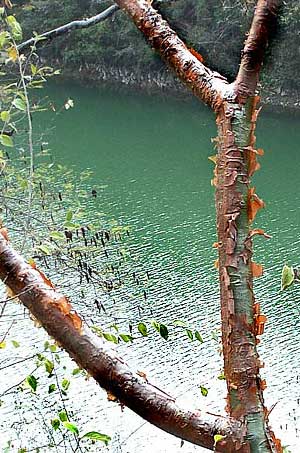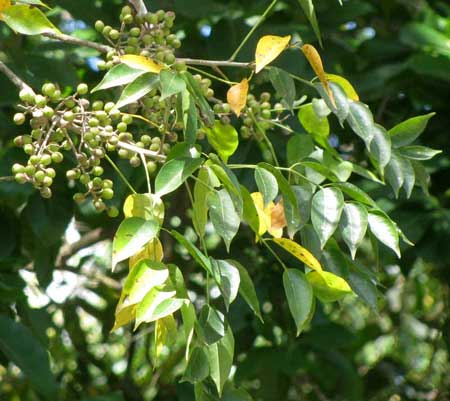 One of the most common and best-known trees in the Yucatan -- in fact of most of Mexico -- catches the eye because of its reddish, flaky bark, shown at the right.
One of the most common and best-known trees in the Yucatan -- in fact of most of Mexico -- catches the eye because of its reddish, flaky bark, shown at the right. One of the most common and best-known trees in the Yucatan -- in fact of most of Mexico -- catches the eye because of its reddish, flaky bark, shown at the right.
One of the most common and best-known trees in the Yucatan -- in fact of most of Mexico -- catches the eye because of its reddish, flaky bark, shown at the right.
The Maya call the tree Chakah, and many savvy visitors call it that, too. However, the same species, Bursera simaruba, also grows in southern Florida, where it's called Gumbo-Limbo, so probably that's the best known English name we have.
Below, you can see Gumbo-Limbo's pinnately compound leaves, which look like those of the North's ash trees. Also you can see the tree's grape-sized fruits, which appear deep in the dry season, in April or so. Birds, squirrels and other critters relish the fruits, often eating them before they turn their mature purplish. Humans find the fruits bitter, tasting like a blend of menthol and pine resin.

Gumbo-Limbo's wood is brittle and juicy, and its sap smells a little like turpentine. I read that in the Caribbean people use its resin as glue, varnish, water-repellent coating, and incense. Gumbo-Limbo is considered medicinal nearly everyplace it grows. In fact, it's one of those plants whose listed cures are so varied that you suspect them all. However, its sap has such a clean, crisp odor that just smelling it probably makes you feel better.
Something else impressive about Gumbo-Limbo is that it's very flexible in terms of habitat requirements. You find it holding its own in fairly undisturbed forests as well as appearing as a "weed tree" along roads and in chopped-over cornfields. In southern Florida it makes a handsome street-tree.